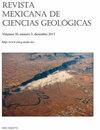墨西哥古生代海百合(棘皮科:绿百合总科、囊胚总科、海百合总科)的多样性墨西哥古生代海百合(棘皮科:绿百合总科、囊胚总科、海百合总科)的多样性
IF 0.5
4区 地球科学
Q4 GEOSCIENCES, MULTIDISCIPLINARY
Revista Mexicana De Ciencias Geologicas
Pub Date : 2022-03-30
DOI:10.22201/cgeo.20072902e.2022.1.1665
引用次数: 0
摘要
含有棘皮动物的墨西哥古生代露头分布在该国的北部、中部和南部,主要分布在下加利福尼亚州、索诺拉州、奇瓦瓦州、塔毛利帕斯州、科阿韦拉州、伊达尔戈州、普埃布拉州、格雷罗州、瓦哈卡州和恰帕斯州。这些岩石对应于沉积在温暖浅层环境中的海相碳酸盐岩,年龄约为541 ~ 251 Ma。同时还包含多种多样的生物群,包括叶根状藻类、有孔虫、珊瑚海绵、珊瑚、苔藓虫、腕足动物、软体动物、三叶虫和棘皮动物。为了了解墨西哥古生代criinozoa的多样性,对该国记录的物种进行了分析,目的是为墨西哥的生物地层学和古地理知识做出贡献。研究方法包括对墨西哥古生代棘皮动物文献资料的详细分析。寒武系绿红类(Gogia和ubagsicystis)主要分布在索诺拉。石炭纪和二叠纪的海盆类板块,特别是Cyclocaudex属、Cyclocrista属、Heterostelechus属、Lamprosterigma属、Mooreanteris属、Pentagonopternix属、preptopremum属和Pentaridica属的形态种,广泛分布在全国各地。对密西西比-二叠纪生物群的分析表明,这项工作所研究的动物群的世界性分布是由于北美西部海洋和东亚海洋之间的联系。索诺拉的晚二叠纪底栖动物广泛分布在从北美西部延伸到北非和亚洲的特提斯王国。对古生代海相地层演替及其生物含量的综合研究,为研究古生代碳酸盐岩相的动物迁移提供了依据。它还有助于重建墨西哥古生代的地理、气候和生态特征。本文章由计算机程序翻译,如有差异,请以英文原文为准。
Diversity of Crinozoa (Echinodermata: Eocrinoidea, Blastoidea, Crinoidea) from the Paleozoic of MexicoDiversity of Crinozoa (Echinodermata: Eocrinoidea, Blastoidea, Crinoidea) from the Paleozoic of Mexico
Paleozoic outcrops in Mexico containing echinoderms are located to the north, center and south of the country, mainly in the states of Baja California, Sonora, Chihuahua, Tamaulipas, Coahuila, Hidalgo, Puebla, Guerrero, Oaxaca, and Chiapas. These rocks correspond to marine carbonates deposited in warm shallow environments, with an approximate age of 541 to 251 Ma. Also containing a varied and diverse biota made up of phylloid algae, foraminifera (fusulinids), coralline sponges, corals, bryozoans, brachiopods, mollusks, trilobites and echinoderms. In order to know the diversity of Crinozoa from the Paleozoic of Mexico, an analysis of the species documented for the country was carried out, with the objective of contributing to the knowledge of the biostratigraphy and paleogeography of Mexico. The methodology consisted of a detailed analysis of bibliographic sources with information on echinoderms from the Paleozoic of Mexico. Cambrian eocrinoids (Gogia, and Ubaghsicystis) are distributed mainly in Sonora. Crinoid plates from the Carboniferous and Permian, particularly morphospecies of the genera Cyclocaudex, Cyclocrista, Heterostelechus, Lamprosterigma, Mooreanteris, Pentagonopternix, Preptopremnum, and Pentaridica, are widely distributed throughout the country. Analysis of the Mississippian-Permian biota indicates that the cosmopolitan distribution of the fauna studied in this work is due to the connections between the seas of western North America and eastern Asia. The Late Permian benthic fauna of Sonora was widely dispersed in the Tethyan realm, which stretched from western North America to North Africa and Asia. The comprehensive study of Paleozoic marine stratigraphic successions and their biotic content provided information on faunal migrations regarding the Paleozoic carbonate facies. It also contributed to reconstructing the geographical, climatological, and ecological characteristics of the Paleozoic of Mexico.
求助全文
通过发布文献求助,成功后即可免费获取论文全文。
去求助
来源期刊

Revista Mexicana De Ciencias Geologicas
地学-地球科学综合
CiteScore
1.00
自引率
12.50%
发文量
0
审稿时长
6-12 weeks
期刊介绍:
Revista Mexicana de Ciencias Geológicas (RMCG) publishes original research papers on geological processes of broad interest, and particularly those dealing with regions of Latin America. The RMCG also publishes review papers on topics of current interest, and on the geology and tectonics of geological provinces of Latin America. Besides, it offers the opportunity for host editors to publish special thematic issues.
 求助内容:
求助内容: 应助结果提醒方式:
应助结果提醒方式:


